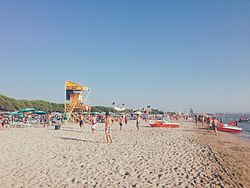This article has multiple issues. Please help improve it or discuss these issues on the talk page . (Learn how and when to remove these messages)
|

This is a list of beaches in Albania, listed geographically by coastline. [1]
This article has multiple issues. Please help improve it or discuss these issues on the talk page . (Learn how and when to remove these messages)
|

This is a list of beaches in Albania, listed geographically by coastline. [1]



Albania's Adriatic coastline lies mainly on the eastern side of the Adriatic Sea, emerging from the Buna estuary, where the designated boundary line with Montenegro is drawn and stretching all the way down toward the Karaburun Peninsula, where Gjuhëza Cape is its westernmost point. [2]
Numerous rivers flowing into the Adriatic Sea form bays, lagoons and inlets. The sand and silt they bring are deposited in areas of reduced flow, which form the sides of the bays, with narrow swales. The depositional coastline is characterized by a low elevation on a slightly uneven relief, with the presence of sandy beaches and lagoons aligned primarily in a North-South orientation. [3] Some areas of the coast are highlighted by sand dunes covered in Mediterranean vegetation. The coastal section of the Western Lowlands is continually expanding through land reclamation, while other areas of the coast experience erosive deterioration, as is the case in Patok, the Seman estuary and Lalzi bay. The Bay of Vlorë features high and rocky cliffs, particularly around the Karaburun Peninsula. [4]
The total length of the coastline is approximately 274 km (170 mi), of which 178 km (111 mi) consist primarily of white sandy beaches and the rest of various landforms of the sea coast. The most popular beaches by number of visitors include Durrës, Golem, Lalzi Bay, Shëngjin, Velipojë, Divjakë, Spille, etc. [5]



The Ionian coast extends from Gjuhëza Cape to the Bay of Ftelie in a Northwest-Southeast orientation. The coastline is characterized by rugged, eroded tectonic formations with towering cliffs, numerous capes, and a combination of small horseshoe-shaped bays and sandy beaches. Some notable bays along the coast include Ftelie, Butrint, Saranda, Kakome, Borsh, Porto Palermo, Spile, Jal and Bristan (Arushë). The main peninsulas are Ksamil, Qefali and Karaburun.
The coastline stands out for its high abrasive intensity, primarily due to the deep sea and the absence of river discharges. Waves can surge to heights exceeding 4 meters, colliding against the rocky shores.

Pogradec Beach lies on the shores of Lake Ohrid, in the eastern municipality of Pogradec. It was formed due to the lake's surface reduction caused by tectonic subsidence, leading to the discovery of sandy deposits brought by the stream flowing through Pogradec and other streams entering the lake.